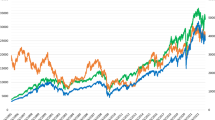Abstract
In this study, we show that earnings forecasting creates an index-tracking portfolio that dominates the historical model trade-off curve. We find that using Toyo Keizai earnings forecasts improves geometric means by over 300 basis points compared to the historical model. Weighted latent root regression is used in this study to create portfolios that have outperformed the Japanese market in backtest and in real-time performance.
Similar content being viewed by others
References
A.E. Beaton and J.W. Tukey, The fitting of power series, meaning polynomials, illustrated on bank-spectroscopic data, Technometrics 16 (1974) 147–185.
D. A. Belsley, Collinearity and Forecasting, J. Forecasting 3 (1984) 183–196.
D.A. Belsley, A.E. Kuh and R.E. Welsch,Regression Diagnostics — Identifying Influential Data and Sources of Collinearity (Wiley, 1980).
M. Bloch, J.B. Guerard, H.M. Markowitz and P. Todd, A comparison of some aspects of US and Japanese equity markets,Cross-Border Investments and Valuation Conf., New York University (September 1991).
L. Breiman, Optimal gambling system for favorable games,Proc. 4th Berkeley Symp. on Mathematical Statistics and Probability (1961), pp. 63–68.
D. Bunn, Editorial: Forecasting with more than one model, J. Forecasting 8 (1989) 161–166.
L. Chan, Y. Hamao and J. Lakonishok, Fundamentals and stock returns in Japan, J. Fin. 46 (1991) 1739–1764.
V.K. Chopra and W.T. Ziemba, The effects of errors in means, variances, and covariances on optimal choice, J. Portfolio Manag. (1993) 6–11.
R.T. Clemen, Combining forecasts: A review and annotated bibliography, Int. J. Forecasting 5 (1989) 559–584.
R. Conroy and R. Harris, Consensus forecasts of corporate earnings: Analysts' forecasts and time series methods, Manag. Sci. 33 (1987) 725–738.
S. Cottle, R.F. Murray and F.E. Block,Graham and Dodd's Security Analysis, 5th ed. (McGraw-Hill, 1988).
M.D. Darrough and T.S. Harris, Do management forecasts of earnings affect stock prices in Japan?, in:Japanese Financial Market Research, eds. Ziemba, Bailey, and Hamao (North-Holland, 1991).
E. Dimson (ed.),Stock Market Anomalies (Cambridge University Press, 1988).
E.J. Elton and M.J. Gruber,Modern Portfolio Theory and Investment Analysis (Wiley, 1987).
E.J. Elton and M.J. Gruber, Analysts' expectations and Japanese stock prices, Japan and the World Economy 2 (1989).
E.F. Fama and K.R. French, Cross-sectional variation in expected stock returns, J. Fin. 30 (1992) 427–465.
J. Farrell,Guide to Portfolio Management (McGraw-Hill, 1983).
J.B. Guerard, Jr., Linear constraints, robust-weighting, and efficient composite modeling, J. Forecasting 6 (1987) 193–199.
J.B. Guerard, Jr., Optimal portfolio analysis using composite model-tilting, Drexel Burnham Lambert (January 1990).
J.B. Guerard, Jr. and M. Takano, The development of mean-variance efficient portfolios in Japan,IBES Quantitative Seminar, Tokyo (June 1992).
J.B. Guerard, Jr. and M. Takano, Stock selection and composite modeling in Japan, Security Anal. J. 29 (1991) 1–13.
J.B. Guerard, Jr. and B.K. Stone, Composite forecasting of annual corporate earnings, in:Research in Finance 10, ed. A. Chen (JAI Press, Greenwich, CT, 1992), pp. 205–230.
J.B. Guerard, Jr., M. Takano and G. Xu, Composite equity modeling: The problem of survivor-bias in the United States,CRSP Seminar (November 1991).
R.F. Gunst, and R.L. Mason,Regression Analysis and its Application (Marcel Dekker, 1980).
R.F. Gunst, J.T. Webster and R.L. Mason, A comparison of least squares and latent root regression estimators, Technometrics 18 (1976) 75–83.
B. Jacobs and K. Levy, Disentangling equity return regularities: New insights and investment opportunities, Fin. Anal. J. (1988) 18–43.
J. Kelly, A new interpretation of information rate, Bell Syst. Tech. J. 35 (1956) 917–926.
H. Konno and H. Yamazaki, Mean-absolute deviation portfolio optimization model and its application to the Tokyo stock market, Manag. Sci. 37 (1991) 519–531.
H. Latane, Criteria for choice among risky ventures, J. Polit. Econ. (1959) 144–155.
L.C. MacLean, W.T. Ziemba and G. Blazenko, Growth versus security in dynamic investment analysis, Manag. Sci. 38 (1992) 1562–1585.
H.M. Markowitz, The optimization of a quadratic function subject to linear constraints, Naval Res. Log. Quarterly 3 (1956) 111–133.
H.M. Markowitz,Portfolio Selection: Efficient Diversification of Investments (Wiley, New York, 1959).
H.M. Markowitz,Mean-Variance Analysis in Portfolio Choice and Capital Markets (Basil Blackwell, Oxford, 1987).
H.M. Markowitz, Investment for the long run: New evidence for an old rule, J. Fin. 36 (1976) 1273–1285.
H.M. Markowitz, P. Todd, G. Xu and Y. Yamane, Fast computation of mean-variance efficient sets using historical covariance, Daiwa Securities Trust Company (1991).
H.M. Markowitz and G. Xu, Data mining corrections, submitted.
H.M. Markowitz, Trade-off curves using 250 vs 500 daily observations, Daiwa Securities Trust Company (1992).
J.D. Miller, J.B. Guerard, Jr. and M. Takano, Bridging the gap between theory and practice in equity selection modeling: Case studies of US and Japanese models, submitted.
A. Rudd and B. Rosenberg, Realistic portfolio optimization, in:Portfolio Theory: 25 Years Later, eds. Elton and Gruber (North-Holland, 1979).
J.T. Webster, R.F. Gunst and R.L. Mason. Latent root regression analysis, Technometrics 16 (1974) 513–522.
W.T. Ziemba, Fundamental factors in US and Japanese stock returns,Berkeley Program in Finance, Santa Barbara, CA (September 1990).
W.T. Ziemba,Invest Japan (Probus Publ. Co., Chicago, 1992).
Author information
Authors and Affiliations
Rights and permissions
About this article
Cite this article
Guerard, J.B., Takano, M. & Yamane, Y. The development of efficient portfolios in Japan with particular emphasis on sales and earnings forecasting. Ann Oper Res 45, 91–108 (1993). https://doi.org/10.1007/BF02282043
Issue Date:
DOI: https://doi.org/10.1007/BF02282043




